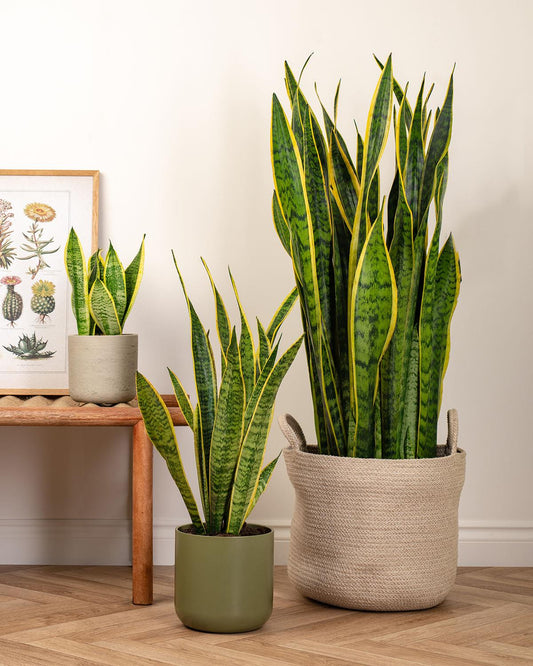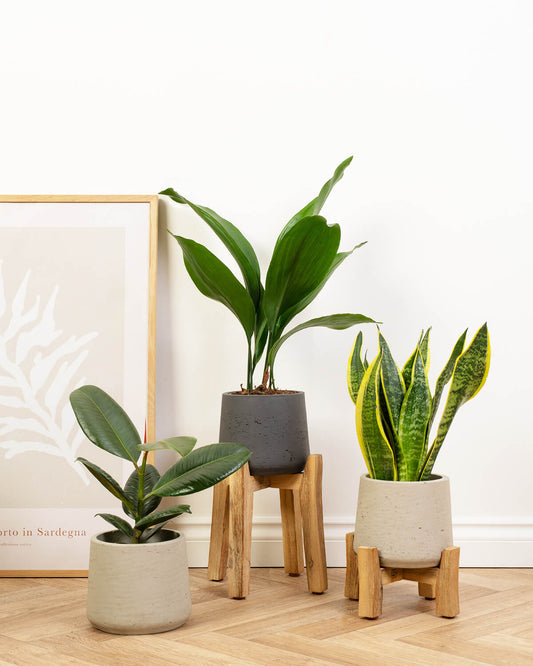The Snake Plant is quite possibly the most popular house plant in the UK and is without doubt in the top 5 indoor plants - and for good reason! The plant boasts eye-catching foliage, the ability to flower in the right conditions, and made it onto NASAs list of best air purifying plants. There is a wealth of different varieties of Snake Plant, all with subtle differences in colouring, size, and foliage.
We can’t wait to introduce you to the Snake Plant family!
Care Guide
Other Names – Sansevieria, Mother-in-law’s Tongue, Viper’s Bowstring Hemp, St. George’s Sword.
Botanical Name – Dracaena trifasciata (formerly Sansevieria trifasciata or Sansevieria laurentii).Family – Dracaena
Originated – West Africa
Light Requirements – Bright, indirect light but is also shade tolerant.
Water Requirements – Infrequent watering, it is known as one of the drought resistant indoor plants. Water when the soil has dried out completely.
Humidity Requirements – Keep the plant dry and avoid misting, as it does not like humidity. Who does?!
Temperature – Ideally between 15 and 23 degrees. Minimum of 10 degrees.
Air Purifying – Converts carbon dioxide into oxygen. Filters and removes formaldehyde, trichloroethylene, xylene, toluene and benzine. Impressive, right?
Pet Friendly – No. Produces saponins which are toxic for most pets and especially dangerous for dogs. Sorry, pups.
Growth Rate – Slow (max. height normally about 1 metre)
Snake Plant
- Regular price
- From £14.00
- Regular price
-
- Sale price
- From £14.00
- Unit price
- per
Unkillable Bundle
- Regular price
- £45.00
- Regular price
-
£45.00 - Sale price
- £45.00
- Unit price
- per
Tips for Indoor Plants – Snake Plant
The Snake Plant is the perfect houseplant for those that are just starting out with plant pets as it requires very little attention, and it grows in most environments. Unlike other houseplants, the Snake Plant is a very robust and resilient plant, and it rarely gets sick naturally.
Most health hiccups with your new plant pet will be as a result of a plant parent mistake, such as overwatering or leaving the plant in a humid room. Many guides recommend keeping a Snake Plant in the bedroom, but you will need to make sure that the bedroom is being well ventilated (when we breath we create lots of humidity). A fantastic place to house your new plant pet is in the conservatory or the entrance hall, as these are areas that tend not to have as much humidity and should have access to the bright light that the Snake Plant is happiest in.
The Snake Plant loves being left by a window and at smaller sizes, the windowsill is probably the most ideal place to settle them in. When they grow larger, a window may not be a practical place to keep your plant pet. Make sure that the window you pick isn’t one that you leave open as rainfall, mist or morning fogs can easily upset the happy, sunny, dry balance your Snake Plant enjoys.
Watering Your Snake Plant
Snake Plants are succulents which as you may know, means they are very stingy with their water. Normally we have routines when watering house plants, but with the snake plant you will want to do the bare minimum. A rule of thumb is to border on what you would consider negligent with your plant pet’s water needs and water only when the soil is bone dry!
Overwatering a Snake Plant can lead to your beloved plant pet falling ill – or even dying. Two things will happen if you overwater your Snake Plant.
-
The leaves are designed to hold water, but if you overwater the Snake Plant the leaves will be overburdened by the amount of water and become mushy and soggy. A pulpy plant pet is your first sign that your Snake Plant has too much water and if you catch it at this stage, you’re lucky. It is best to just leave the plant alone and not water it for a considerable period of time (maybe even a month or more).
-
The leaves turn greenish-yellow, yellow or wilt and turn brown. When the Snake Plant leaves begin to change colour, the plant is really showing signs of distress. At this stage you should be prepared that your plant pet may not make it. Again, the course of action is to neglect all watering duties for a long period of time, but be warned, the changing colours often point to the roots rotting and dying.
There is one last rare sign that your Snake Plant is being overwatered and surprisingly it doesn’t present on the plant itself. Mould and fungus can form a layer on the soil around a Snake Plant if it is too damp – you will need to repot the plant completely if this happens in dry fresh soil, being doubly certain to clean the roots and plant carefully to remove any mould spores.
Final Prickle Tips for Your Snake Plant Pet
For the most part, outside of a plant parent mistake, the Snake Plant is indestructible. You may notice that the leaves scar occasionally, but this is nothing to be concerned about and is completely normal. Stay plant body positive! If the leaves get brown tips (not to be confused with the entire brown leaves above) then a slight mist to rehydrate the tips is fine – just don’t overdo it.
You can feed your Snake Plant every two weeks to encourage healthy (and faster) growth. If you’re keeping it in a room where people spend plenty of time such as the living room or a bedroom, make sure that the plant is in a well ventilated and dry area.
And that pretty much sums up the slithering Snake Plant, unless we have missed something? If we have let us know and make sure to join our Prickle plant pet community by following our social media channels.



